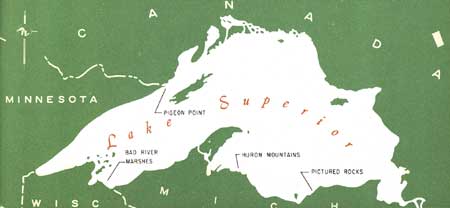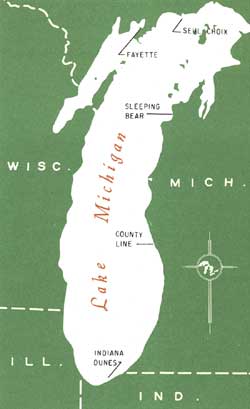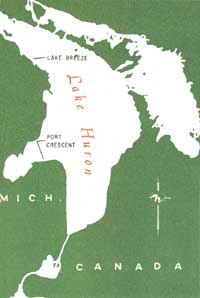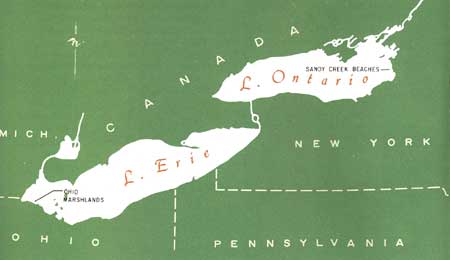.gif)

Our Fourth Shore
Great Lakes Shoreline
MENU
|
OUR FOURTH SHORE: Great Lakes Shoreline Recreation Area Survey |

|

(click on image for an enlargement in a new window)

Lake Superior
Lake Superior receives its name from its upper or northern position to the other Great Lakes, but the name applies equally well to its scenery. The shores of Lake Superior are the wildest, most untrammeled and unaltered on the Great Lakes scene. The main alterations of scenic areas have been in the removal of the climax forests and their widespread replacement by birch, aspen and pin cherry stands. Nonetheless, mile upon mile of Lake Superior shore lies essentially free of the incursions of man. Little wonder then that four of the seven areas designated by this Survey as possessing possible national significance should be located along its shores.
The Minnesota North Shore of Lake Superior is a rugged, rock-bound coast of shore cliffs and quaint coves, waterfalls and enchanting vistas. It is rich in geologic significance and scenic attractions. The culmination of these qualities lies in the long, rocky spine of Pigeon Point. The austere coniferous forests, cliff-shrouded Wauswaugoning Bay, the rocky offshore islands and the falls of the Pigeon River impart to the area an air of solemn awe.
Southeast of Wisconsin's Bayfield Peninsula are the wild rice marshes of the Bad and Kakagon Rivers. Interspersed with points of higher land, tamarack bogs and other aquatic communities, these vast marshes possess outstanding qualities for waterfowl and other wildlife. In the waters of the sloughs and of Chequamegon Bay is one of the outstanding sport fishing regions of Lake Superior.

Pictured Rocks — triumph of a fluid medium over
resistant rock.
East of Munising, Michigan, some of the most spectacular shoreline scenery on Lake Superior occurs along the famous Pictured Rocks. Sheer sandstone cliffs stand 200 feet above the pounding crescendo of the relentless waves. Over the ages, this fluid medium has fashioned the resistant stone into concave-faced cliffs, sea caves and arches. The study area includes also portions of Grand Island with its superb forest growth, the Beaver Basin with its ancient lake terraces and the Grand Sable Bank with its beautiful perched dunes. Behind the 32 miles of shoreline are lakes, waterfalls, streams, forests and wildlife possessing the essential flavor of the great North Woods.
About midway along Lake Superior's south shore, south of the great projecting prominence of the Keweenaw Peninsula, lies the rugged and scenic topography of Michigan's Huron Mountains. Part of the Superior Upland of Canada's Laurentian shield, the Archean rocks of this area are the oldest known to man. Nestled in the glacial scoured depressions of the Huron Mountains and on the lake plain fronting them lies what is, undoubtedly, the most picturesque group of inland lakes along the Great Lakes shoreline. Superb climax stands of sugar maple, white pine and other northern species make the forests of the Hurons the most extensive stands of basically unaltered forest along the Great Lakes. In this primeval setting, northern mammals and birds live in much the same abundance and security as they did in the days of the Indians.

The spirit of the north woods envelops the Huron
Mountains.
Lake Michigan
 (click on image for an enlargement in a new window) |
Lake Michigan lies entirely within the United States, and, consequently, has the longest shoreline of any of the Great Lakes in our country. With the numerous islands, peninsulas and bays, the total shoreline is 1,661 miles. Lake Michigan trends north and south, and its 300-mile length is sufficient to carry it from the heavily populated agricultural and industrial southern Great Lakes region to the northern forests of the sparsely populated Upper Peninsula.
Certainly the most important stretch of Lake Michigan's shoreline, from a recreation standpoint, is the eastern shore from Michigan's Leelanau Peninsula to Gary, Indiana. Fronting this shore is a wide and almost continuous beach of fine sand backed by dunes which often reach inland for more than a mile and attain heights of over 200 feet.
The dunes of Lake Michigan reach their greatest heights in the Sleeping Bear area of Michigan's Leelanau and Benzie Counties. Perched atop massive bluffs of glacial deposit, these dunes tower over 400 feet above the waters of Lake Michigan. These magnificent dunes, combined with the forest-covered Empire Dunes, the miles of excellent sand beaches, the old beach lines and pine and oak forests of the Platte Plains, the giant cedars, dunes and gull colony of South Manitou Island, the bogs, marshes, lakes and streams of the area and the variety of birds and wildlife make the Sleeping Bear region one of the outstanding recreation and natural areas on the Great Lakes.
The most heavily used part of Lake Michigan's shore is, however, not in Michigan, but in Indiana. The Indiana Dunes, of exceptional extent and height, once stretched unmolested for 26 miles along the Indiana shore. Today, caught up in the expanding industrial and suburban complex of the Chicago area, only 3-1/2 miles of shoreline in the Indiana Dunes State Park remain in a protected natural state. With a population of five million people in a radius of 50 miles, the recreation pressures on this area are tremendous. Besides the State Park, another 5.5 miles of undeveloped shoreline are held by three large steel companies. This portion of the dunes has been announced as the site of a harbor development and multi-million dollar steel plant, the erection of which seems imminent. Nonetheless, in view of the tremendous recreation potential of the area, it takes on immense regional importance and the situation warrants further study.
From Chicago to Wisconsin's Door Peninsula, the western shore of Lake Michigan is characterized by rather narrow beaches backed by shore bluffs. Farmlands, cottage developments and industrial plants line the shore and only two study areas, both extensions of existing state parks, were considered. However, on Wisconsin's Door Peninsula and along the south shore of Michigan's Upper Peninsula, several important areas came to light. Two in Michigan (the Fayette ghost town and the Seul Choix beaches) are of outstanding state park caliber.

The Sleeping Bear Dunes — a scenic blending of
surf, sand, forest and plain.
Lake Huron
 (click on image for an enlargement in a new window) |
Just as sand dunes and beaches characterize much of the eastern Lake Michigan shoreline, so limestone shores are typical of great sections of Lake Huron. Although it is the second largest of the Great Lakes, Lake Huron's 740 miles of shoreline in the United States—including its several islands—all lie within the state of Michigan. Being a lee shore, it is protected somewhat from the prevailing westerly storms. Extensive dune formations occur only along the northerly facing shores of Presque Isle and Huron Counties.
The waters of Lake Huron near shore are mostly very shallow, and the lake bottom, resting on the limestone base overlaid with glacial debris, is often quite rocky. Shallow bays and shores in the lee of strong currents, however, have accumulated sufficient sand to form excellent bathing beaches.
Intensive cottage development has consumed much of the shoreline south of Saginaw Bay, but the northern shores still offer several opportunities for preserving areas for public benefit and enjoyment. Of the 14 areas studied by the Survey on Lake Huron and the St. Marys River, two are of outstanding state caliber. They are Port Crescent and Lake Breeze.

Top: Lake Breeze Shores — Lake Huron scenery at
its best. Bottom: Port Crescent-sandy shores for southeastern Michigan's
huge population.

(click on image for an enlargement in a new window)
Lakes Erie and Ontario
The eastern Great Lakes — Erie and Ontario — differ from Lakes Huron, Michigan and Superior in one highly important respect. Their shoreline in the United States lies almost entirely within an agricultural region. Where land along the shoreline has not been occupied for towns, cities, cottage developments or industrial concerns, it is primarily in farmland. Consequently, little remains of the unaltered natural scene.
Western Lake Erie is extremely shallow, the water is warm and inclined to be turbid. Fish life is abundant and provides pleasant sport for anglers. Marshes which formerly extended a considerable distance inland have been largely drained, but a fringe of marsh of great importance to waterfowl remains. It is here that the Ohio Marshlands Study Area occurs. The Ohio Department of Natural Resources presently has holdings on both sides of this section of marshland. Acquisition of the area would consolidate the state holdings, making this the most significant waterfowl area in public ownership on the Great Lakes. The national significance of the marshes is currently being studied to determine the feasibility of joint state and federal management.
From Vermilion, Ohio to Buffalo, New York, the beaches are generally narrow and backed by eroding shore bluffs. Much the same situation exists on Lake Ontario from the mouth of the Niagara River to Braddock Point, 10 miles west of Rochester.
From Braddock Point to Pulaski, the most impressive shoreline feature is the presence of numerous drumlins, most conspicuous from Sodus Bay to Oswego. The shoreline is characterized by scenic, eroded bluffs alternating with sloughs, marshes, bogs and streams, making this one of the most unusual shorelines along the Great Lakes.
North from the mouth of the Salmon River near Pulaski extends a 17-mile stretch of shoreline unique on Lake Ontario. It is largely a long barrier beach backed by a single line of dunes up to 40 feet high. Behind the dunes to a depth of one or two miles is a series of ponds and marshes. The beaches are 75 to 200 feet wide and composed of fine, white sand. The marshlands are the finest waterfowl habitat on Lake Ontario, and fishing is popular on all open water areas behind the barrier beach. Development has not proceeded to any appreciable extent because of the lack of firm ground behind the beach. However, several miles have been developed and the threat of future development cannot be discounted. The Sandy Creek Beaches, because of their multiple use possibilities and their fine state of preservation, comprise the most outstanding area on Lake Ontario.

The beaches and wildlife habitat near Sandy Creek are
unrivaled on Lake Ontario.
Next >>>
Last Modified: Mon, Dec 22 2003 10:00:00 pm PDT
http://www.cr.nps.gov/history/online_books/shore/shore3.htm
![]()
 Top
Top